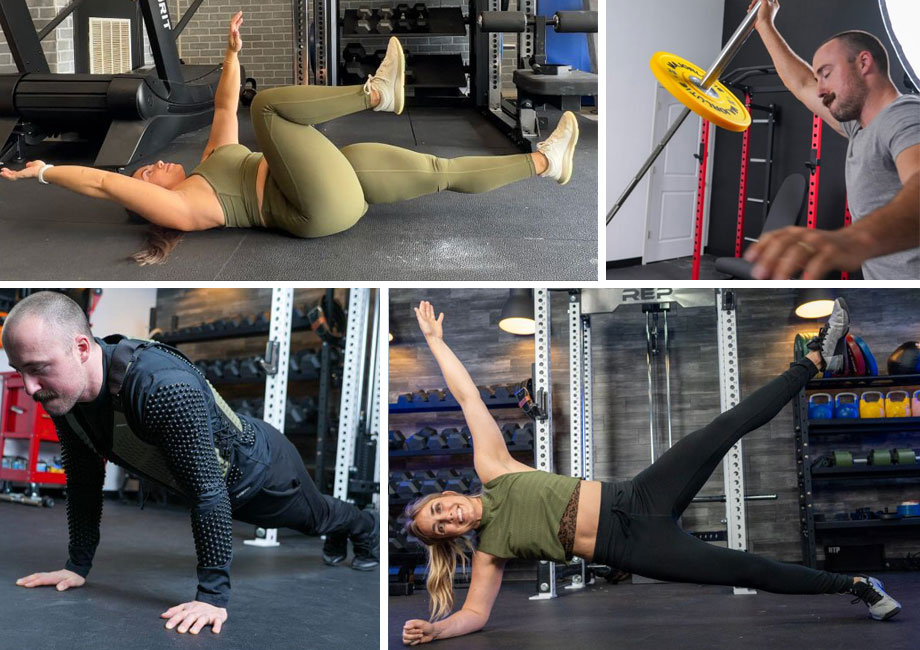We test and review fitness products based on an independent, multi-point methodology. If you use our links to purchase something, we may earn a commission. Read our disclosures.
When you think about training your abs, the first images that probably jump to mind are those shredded, six-pack abs you see on Instagram. You’re not wrong—there are aesthetic benefits of working the core. However, that’s not all. A stronger core can help elevate your compound exercises in the gym, improve your posture, and even reduce lower back pain1.
The great thing is that you can start seeing the above benefits in as little as one month. “How?” you ask. Well, that’s why I’m here. As a certified personal trainer (CPT), I’ve designed a 30-day ab challenge featuring some of the best ab exercises that will—in just five minutes a day—help you to build your core strength.
I’ll start by explaining what you should expect from this challenge should you choose to follow it. Then, I’ll break down, week by week, the exercises to do and how to do them. The exercises will get more challenging as time progresses, and by the end of the 30 days, I’m confident you’ll have more core strength and an expanded repertoire of core exercises to incorporate into your workout routine.
Read on to find out more.
What to Expect From the 30-Day Ab Challenge?
Every 30-day ab challenge is different. I’ve designed one that involves exercising five minutes a day for 30 consecutive days. The first two weeks will be bodyweight-only ab exercises, and in the third and fourth weeks, you’ll start to use dumbbells, weight plates, and ab rollers.
You don’t need to prepare anything in advance, but if you’d like, you can do a quick five-minute warm-up before doing the below workouts.
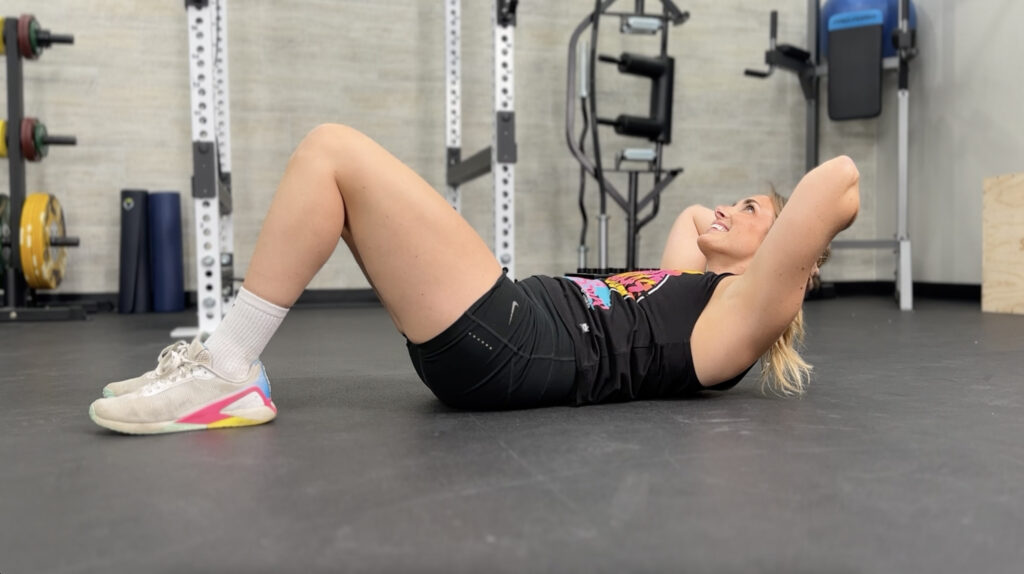
RELATED: Best Warm-Up Exercises
Here’s your complete list of exercises:
Week 1
- Dead Bug
- Toe touch
- Bodyweight Russian twist
- Mountain climber
- Plank
Week 2
- Sit-up
- Lying leg raise
- Plank shoulder tap
- Cross-body mountain climber
- Hollow hold & rock
Week 3
- Weighted crunch
- Hanging knee raise
- Weighted russian twist
- V-up
- Side plank
Week 4
- Ab rollout
- L-sit
- Landmine rotation
- Hanging leg raise
- Side star plank
Week 1
In week one, do the first of the below five core exercises for 30 seconds, take a 30-second break, and move on to the next exercise. You’ll do one round every day of the week, so each workout should last five minutes.
Dead Bugs
Why do it: The dead bug exercise activates several muscle groups, including the rectus abdominis, transverse abdominis, obliques, hip flexors, and lower back. A 2017 study by the Journal of Manipulative and Physiological Therapeutics2 found that the obliques get worked to a greater extent on dead bugs compared to a criss-cross exercise or single-leg stretch because the opposite sides work simultaneously.
How to do it:
- Lie on the floor facing up. Your arms should be extended above your chest, and your legs should be off the floor so your knees are bent at 90-degree angles.
- Bring your right arm down and behind your head, ensuring it stays straight. At the same time, bring your left leg close to, but not touching the floor.
- Return to the starting position and repeat on the other side.
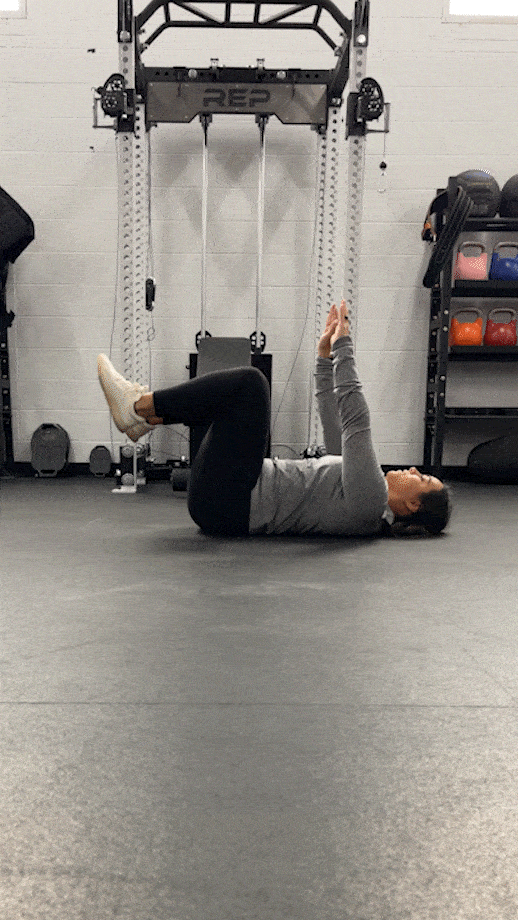
Toe Touches
Why do it: I like toe touches because they hit your abdominal muscles while giving your hamstrings a stretch at the same time. If you can’t lift your toes to begin with, don’t worry. Reach as far as you can and slowly build up your strength and flexibility.
How to do it:
- Lie on your back with your legs close together. Bring your legs toward the ceiling so they’re perpendicular to your body.
- Straighten your arms above your chest. Keeping your core tight, reach toward your feet with your hands (your shoulders will lift off the floor here).
- Slowly return your shoulders to the ground.
- Repeat for reps or duration.
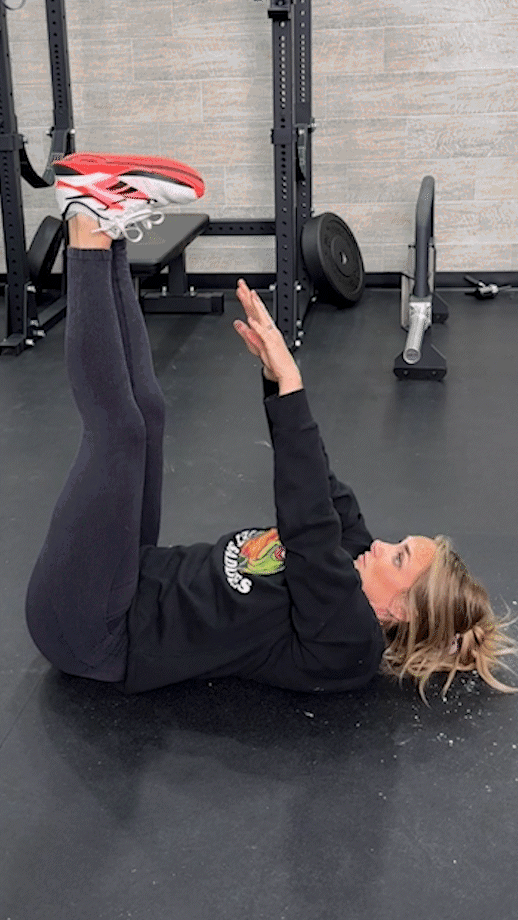
Bodyweight Russian Twists
Why do it: Because your feet are off the ground during the movement, you’ll need to balance yourself, helping improve your coordination. Your obliques and hip flexor muscles will get worked because you’re moving from side to side.
How to do it:
- Sit down on the floor. You’ll want your knees bent at 90-degree angles and your feet flat on the ground.
- Lift your feet and lean back. Clasping your hands in front of your body, twist your torso to the left side as far as possible.
- Hold, before returning to the middle position. This time, twist to the right side.
- Continue rotating back and forth for reps or duration.
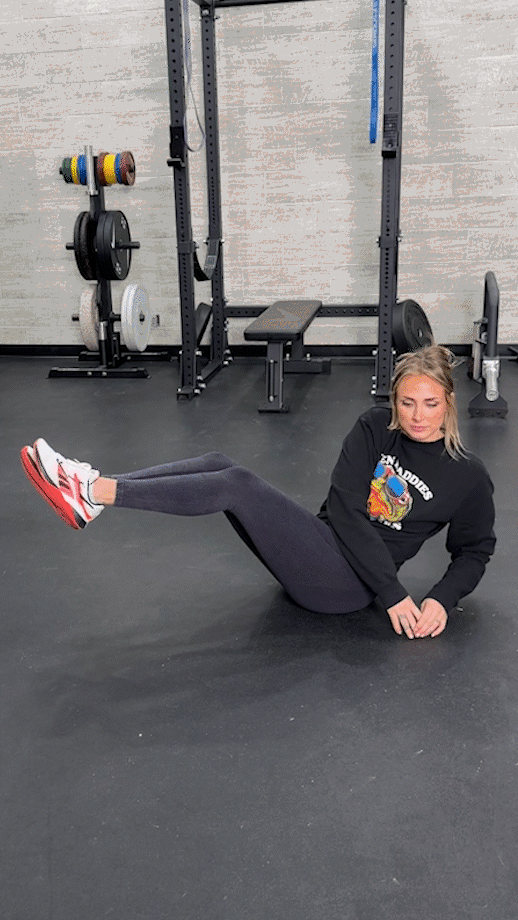
Mountain Climbers
Why do it: Although mountain climbers are popular in HIIT workouts (and therefore, considered more of a cardio exercise), they’re included in this 30-day challenge because doing them slowly and bringing your knee to your elbow builds core strength and stability. It’s important to reset properly after each rep, ensuring your hips don’t sink in.
How to do it:
- Begin in the high plank position with your hands shoulder-width apart.
- Lift your left foot off the floor and bring your left knee to your left elbow. Pause, and then return to the high plank position.
- Replicate the movement on the right side, alternating sides for repetitions.
Expert tip: If you find mountain climbers difficult, you can regress the exercise by performing an incline version by resting your hands on a weight bench, plyo box, or chair. To progress the movement, try performing the cross-body version (opposite knee to elbow) and experimenting with tempo (HIIT).
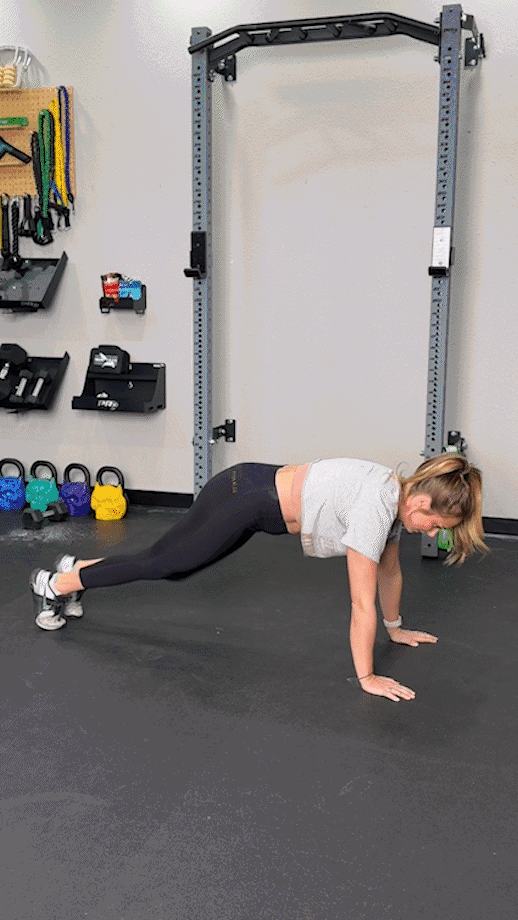
Planks
Why do it: Have you ever seen a six-pack workout without some form of plank? Neither have I! Planks improve respiratory capacity and physical fitness in older adults and may enhance the function of immunocytes, as found in a 2023 study by the Journal of Exercise Rehabilitation3.
How to do it:
- Place your forearms and toes on the floor or one of the best exercise mats, keeping the rest of your body off the ground.
- Brace your core muscles and squeeze your glutes.
- Hold this position for time.
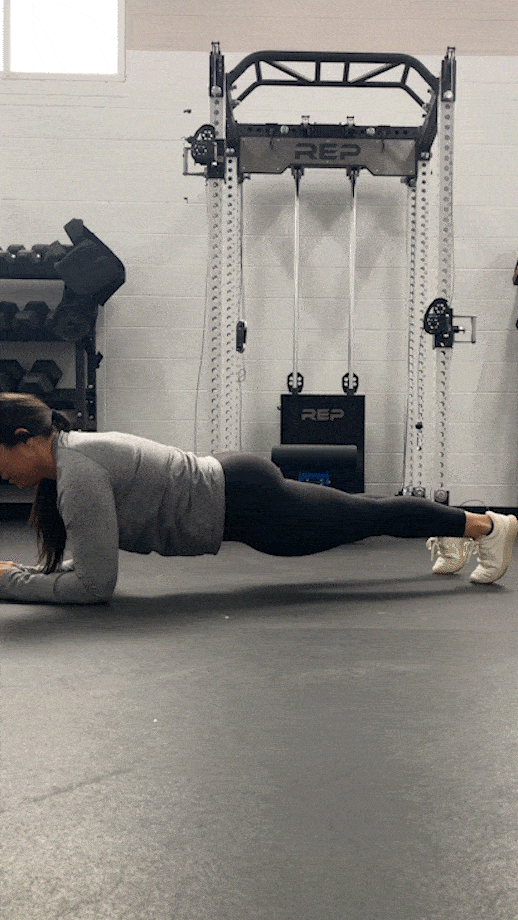
Week 2
Now that you’ve completed week one, let’s take it up a notch. In week two, each workout will still last five minutes, but instead of working out for 30 seconds and resting for 30 seconds, your workout routine will involve working for 40 seconds and resting for 20 seconds.
Sit-ups
Why do it: Sit-ups require no equipment and strengthen your core: a winning combo. To maintain proper form during sit-ups, keep a neutral neck position and use your core to bring you up.
How to do it:
- Lie down on your back facing the ceiling. You’ll want your feet flat on the floor and knees bent at 90-degree angles.
- Clasp your hands behind your head and engage your core. In a controlled manner, lift your upper body so your chest goes toward your knees.
- Pause when you’re upright, and then slowly return to the ground.
- Repeat for reps or duration.
Expert tip: A common sit-up mistake is leading with your neck, which can cause strain or injuries. Remember to always lead with your core.
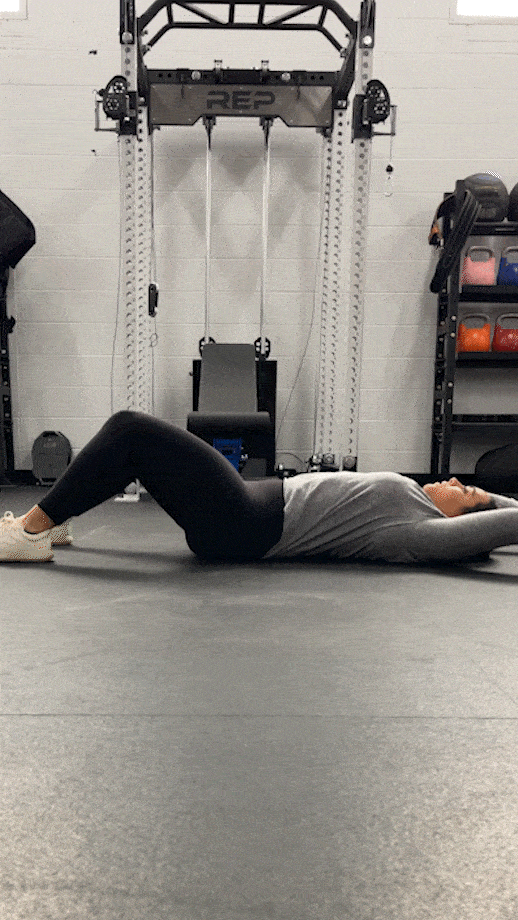
Lying Leg Raises
Why do it: Those looking to sculpt their lower abs will benefit from lying leg raises. With sit-ups (which you saw above), your upper body moves off the ground, and your lower body stays fixed. With lying leg raises, it’s the opposite. You’ll activate your hip flexors, too.
How to do it:
- Lie on your back with your legs straight and feet touching. Your arms should be at your sides and your hands underneath your hips to provide stability.
- Slowly lift your legs until they’re perpendicular to your body, keeping your legs extended.
- Hold before lowering your legs. Get your feet as close to the floor as possible without touching.
- Repeat for reps.
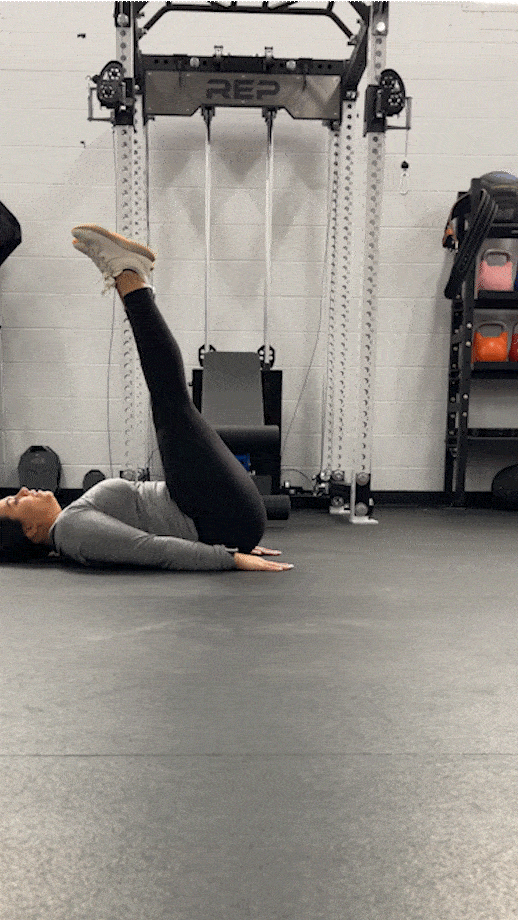
Plank Shoulder Taps
Why do it: Plank shoulder taps have also been included on our list of plank exercises because they work your full body. You’ll hit your core—it’s a 30-day ab challenge, after all—but also activate your quads, hamstrings, glutes, biceps, and triceps.
How to do it:
- Begin in the high plank position (aka the push-up position).
- Keeping your right hand on the floor, lift your left hand and bend your elbow to tap your right shoulder. Then, place your left hand back onto the ground.
- Next, tap your left shoulder with your right hand.
- Continue for repetitions, alternating hands each time.
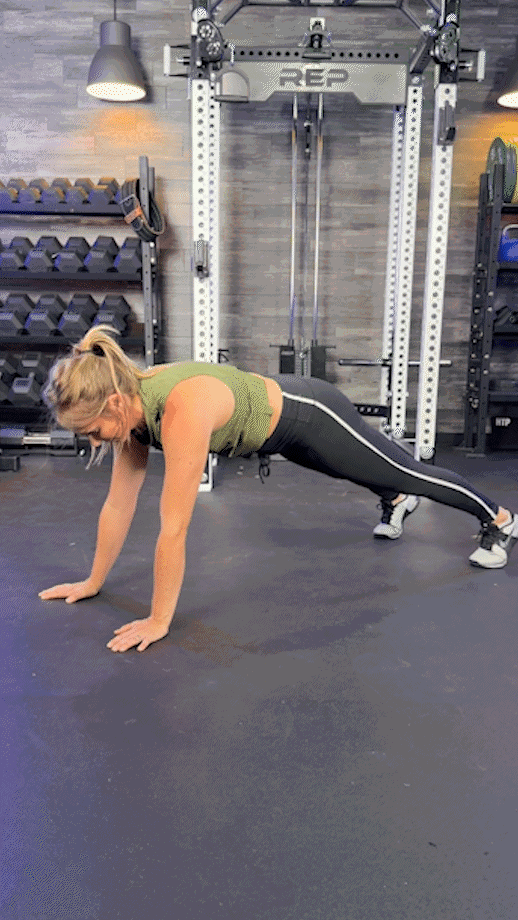
Cross-Body Mountain Climbers
Why do it: Cross-body mountain climbers are similar to regular mountain climbers but with one additional benefit. Because you twist your torso to reach the opposite elbow, there’s more emphasis on the obliques and hip flexor muscles.
How to do it:
- Similar to regular mountain climbers (which you saw above!), start in the high plank position.
- Brace your core. Lift your left foot off the ground and bring your left knee to your right elbow.
- Return to the original position before bringing your right knee to your left elbow. Cycle between the two positions.
RELATED: Hip Flexor Exercises
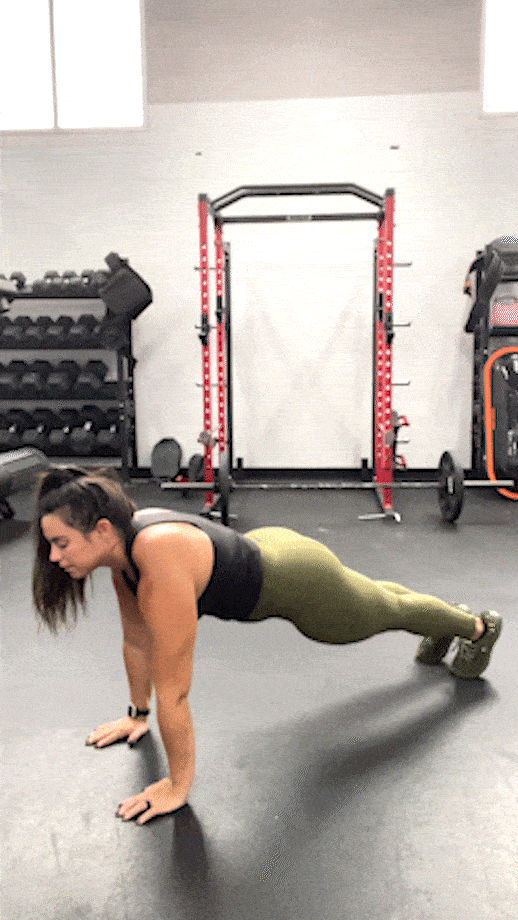
Hollow Hold & Rocks
Why do it: The benefits of a hollow hold workout include improved core strength and the potential to get stronger at compound movements such as squats and deadlifts because you keep a straight back under load during the exercise.
How to do it:
- Lie on the floor facing the ceiling with your legs straight and feet together. Extend your arms above your head so your biceps are close to your ears.
- Press your lower back onto the floor, and lift your arms and legs off the ground.
- Either hold this position or gently rock (hence the name!) forward and backward for the recommended duration of time.
Expert tip: A higher leg position is not better here—your legs should only be about five inches off the ground.
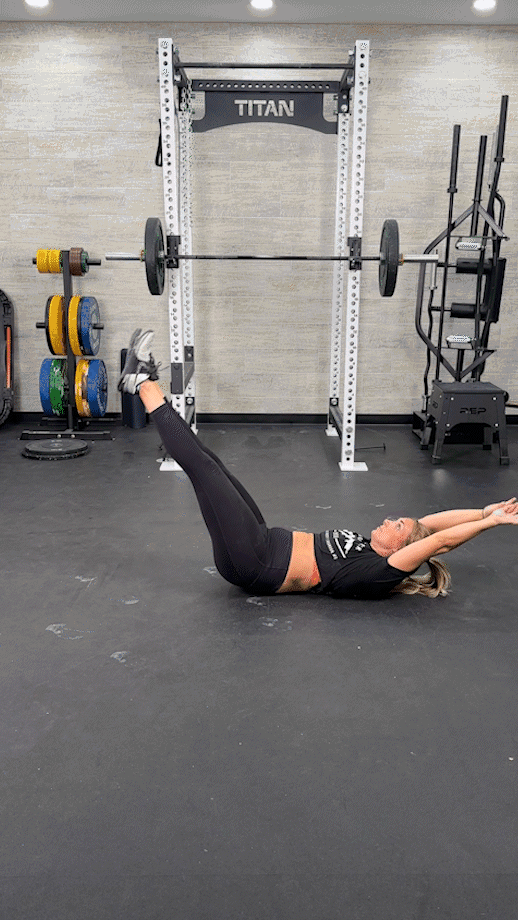
Week 3
Let’s press the accelerator on this workout challenge. During week three, you’ll move away from the bodyweight-only exercises. We’ll introduce some weights and increase the intensity further. You’ll be working for 50 seconds and resting for 10 seconds.
Weighted Crunches
Why do it: The crunches exercise isolates the rectus abdominis, one of the main muscles in the abdominal region. Although you can do bodyweight crunches, I’ve added a dumbbell or weight plate because adding loads may increase the activation of the abdominal muscles4.
How to do it:
- Lie on your back with your feet flat on the floor and knees bent at a 90-degree angle. Hold a weight plate or dumbbell above your chest with your arms extended.
- Brace your core, and then crunch your abs by lifting your upper torso off the floor.
- Slowly return to the ground with control.
- Repeat for reps.
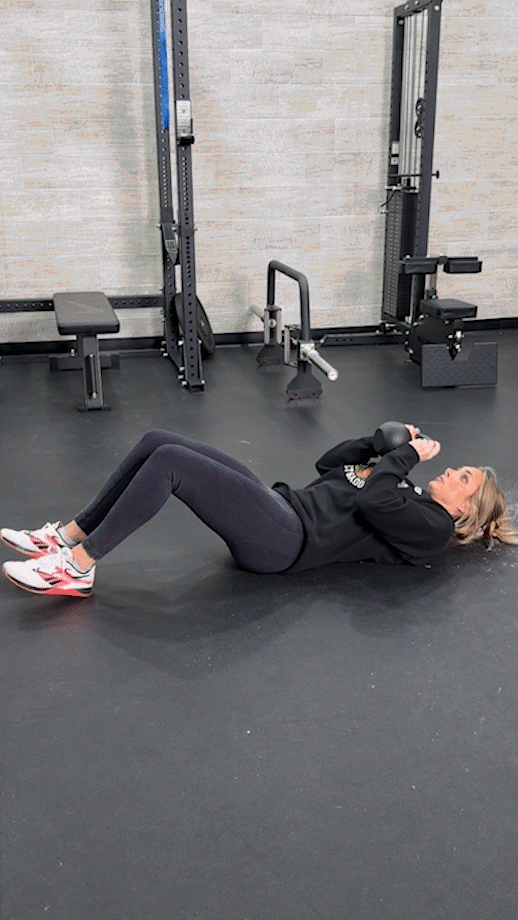
Hanging Knee Raises
Why do it: Remember how I mentioned that leg raises are a fantastic way to work the lower abs because your leg lifts off the ground rather than the upper body? Well, imagine this from a hanging position. You’ll engage your core, forearms, and upper back in addition to improving your grip strength.
How to do it:
- Get into the dead hang position on a pull-up bar. You’ll want either an overhand grip (palms facing away from you) or a neutral grip (palms facing each other).
- Engage your core, and then lift your knees toward your chest without using momentum.
- Pause before returning to the dead hang position in a controlled manner.
- Repeat for reps or duration.
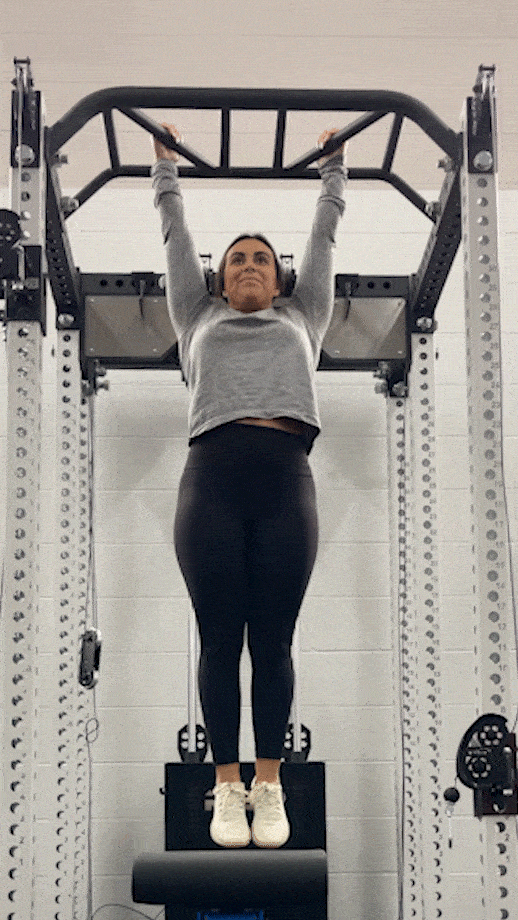
Weighted Russian Twists
Why do it: Adding load to this exercise makes it more challenging, and the great thing is that you can tailor it to your individual needs. There’s no limit when it comes to weighted Russian twists.
How to do it:
- Sit on the floor with bent knees and flat feet. Take hold of a dumbbell, kettlebell, medicine ball, or even a can of baked beans and position your hands in front of you.
- Lean back, lifting your feet off the ground. Twist to the left as far as possible before slowly returning to the middle.
- Replicate the movement on the right side.
- Continue rotating back and forth for reps or duration.
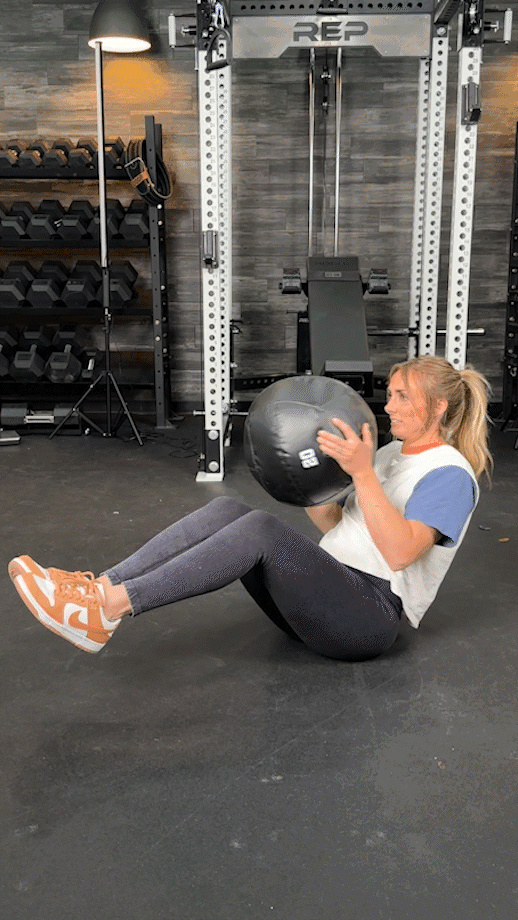
V-Ups
Why do it: Although V-ups don’t require weights to perform them, they’re one of the more challenging bodyweight ab exercises. This is because your arms and legs are moving at the same time, improving your coordination and core strength.
How to do it:
- Lie on the floor, facing the ceiling. You’ll want your legs and arms extended and close together.
- Activate your core. While keeping both your legs and arms straight, simultaneously bring them toward the center of your body (so you’re effectively trying to touch your toes).
- Hold before reversing the motion.
- Repeat for reps.
Expert tip: If regular V-ups become too easy, hold a dumbbell or kettlebell for extra resistance.
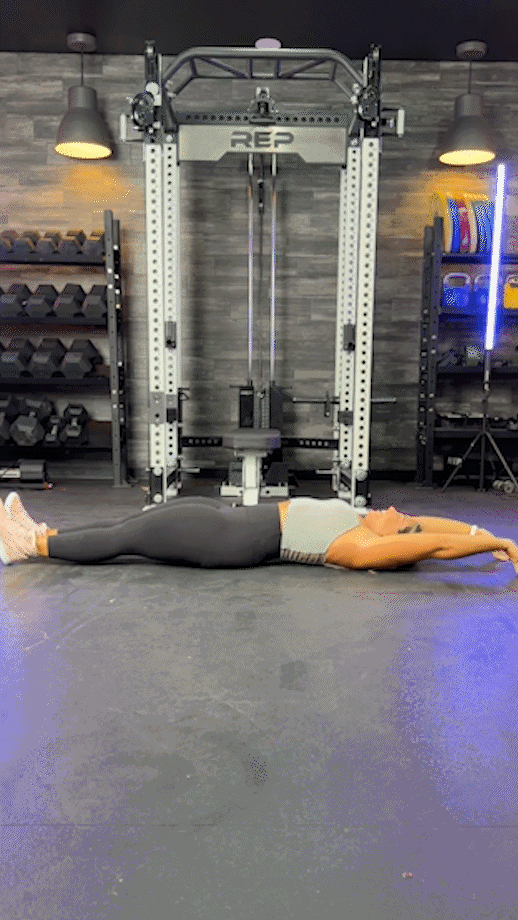
Side Planks
Why do it: You’ll hit your obliques, hip flexors, glutes, and shoulders. Your balance and coordination may also improve because you’re holding yourself up using only your forearm and core.
How to do it:
- Lie on your left side with your legs straight and left forearm on the floor.
- Engage your abs, and then lift your hips and knees away from the ground. You’ll want to make sure there’s a straight line from your head to your toes.
- Hold this position for half of the recommended duration of time, and then switch to the opposite side for the other half.
Expert tip: I recommend side planks to clients who are finding that other core exercises are painful for either their necks or lower back.
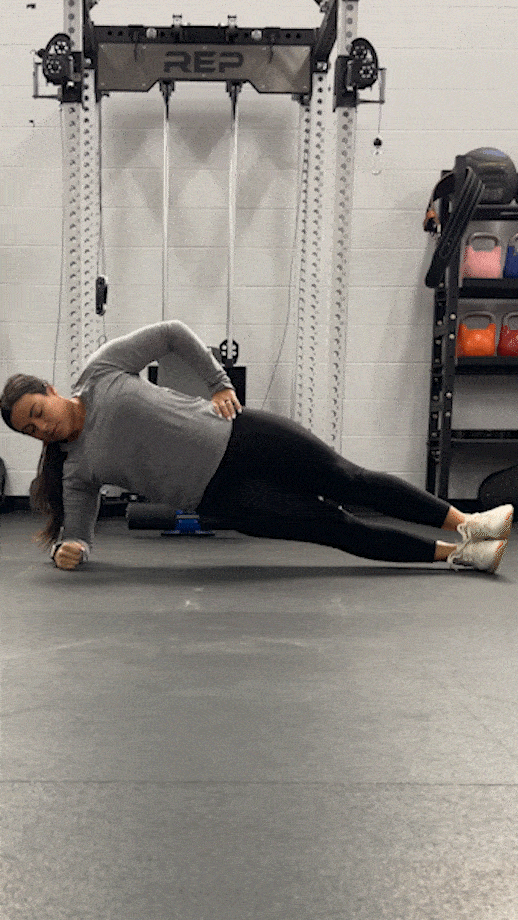
Week 4
You’ve reached the home stretch! Do each of the following five exercises for 60 seconds, one after the other. That’s right—there’s no time for rest here.
Ab Rollouts
Why do it: Doing ab rollouts strengthens the core muscles and improves your posture. If you don’t have an ab roller, replicate the movement using a barbell and weight plates. However, it’s worth noting that the barbell version is easier for most people because you’re higher to the ground and more stable when compared to an ab wheel.
How to do it:
- Begin on your knees and take hold of a barbell or one of the best ab rollers on either side.
- With straight arms and an engaged core, roll forward. Keep going until your chest and hips are as close as possible to the floor.
- Pause, and then squeeze your lats to pull yourself to the original position.
- Repeat for reps.
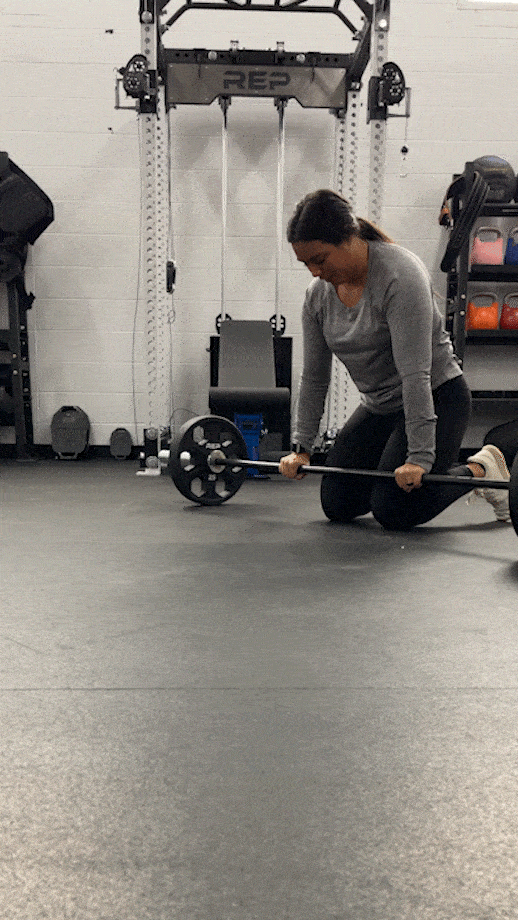
L-Sits
Why do it: It’s a functional core exercise that will not only help with your fitness goal of strengthening your core, but will also activate your hip flexors, upper back, arms, chest, and quads. Holding this position for 60 seconds is also an excellent test of your mental fortitude.
How to do it:
- Using either an overhand grip (palms facing away from you) or a neutral grip (palms facing each other), get into the dead hang position on a pull-up bar.
- Brace your core, and then lift your legs so your body forms the letter “L.”
- Hold this position for time.
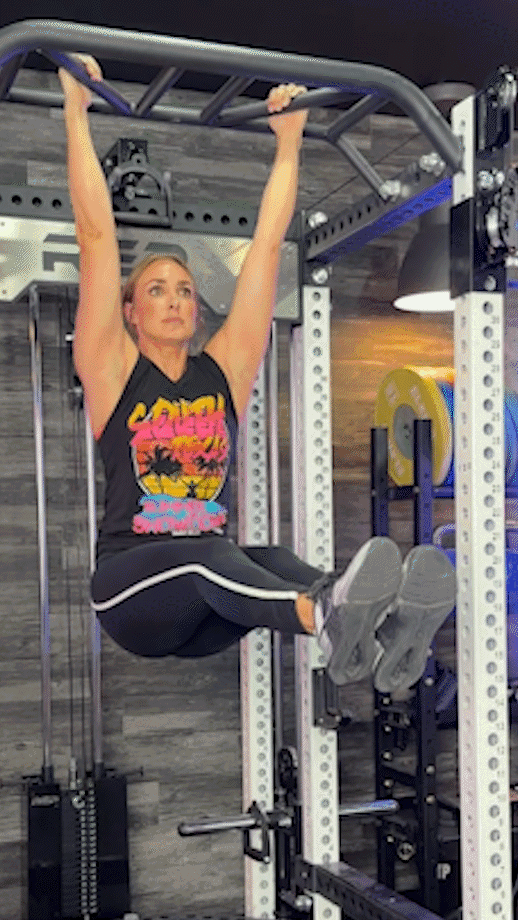
Landmine Rotations
Why do it: Also known as landmine rainbows or landmine 180s, this landmine exercise hits the obliques, rectus abdominis, transversus abdominis, and lower back. If you think about it, it’s similar to Russian twists, but I prefer landmine rotations because your feet are flat on the floor, meaning you can add more load to the movement.
How to do it:
- Load the attachment with the desired weight, and then stand close to it, facing the landmine base. You’ll want your feet hip-width apart.
- Squat down and grab the bar with both hands. Stand up, making sure your arms are straight and your chest is lifted.
- Bring the bar to your left hip by rotating your torso, and then slowly return it to the middle, then move the bar to the right hip.
- Continue for the desired number of repetitions, alternating between the left and right sides.
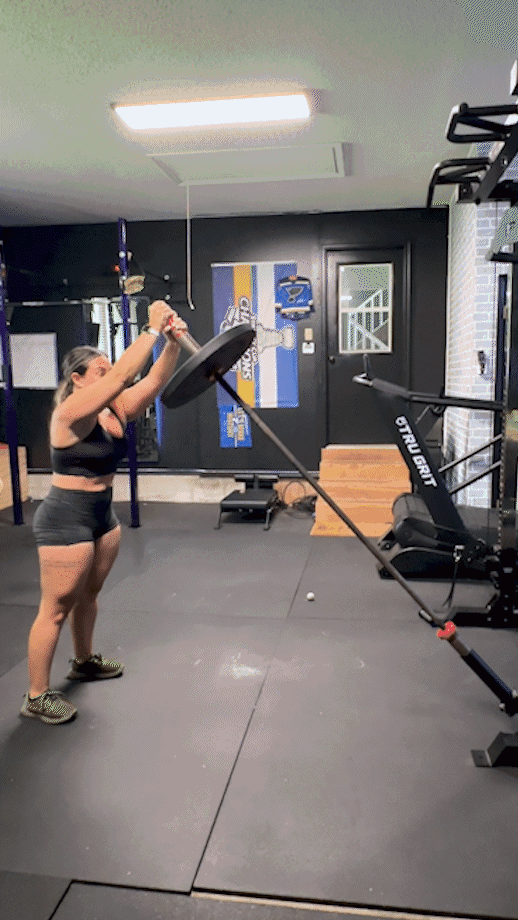
Hanging Leg Raises
Why do it: Hanging leg raises are a progression of lying leg raises and hanging knee raises and work your lower abs to a greater extent.
How to do it:
- Step onto a pull-up bar with either an overhand or neutral grip. Take your feet off to get into the dead hang position.
- Activate your core muscles, and then raise your legs until they’re perpendicular to your body. Pause.
- In a controlled manner, lower your legs to the starting position.
- Repeat for reps.
Expert tip: If you want an additional challenge, place a dumbbell between your feet.
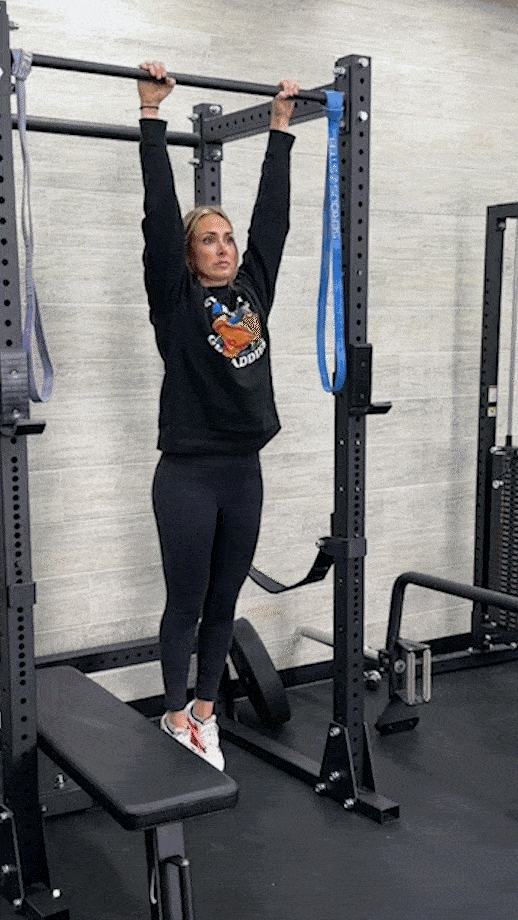
Side Star Planks
Why do it: It’s an advanced move that’ll improve your balance and increase muscle activation in your abdominal region.
How to do it:
- Get into the side plank position above with your left forearm on the floor.
- Instead of holding the side plank, raise your right leg into the air so there’s a 45-degree angle between both of your legs.
- Bring your right leg down, and continue lifting it up and down for half of the recommended time duration.
- Switch to the opposite side and repeat.
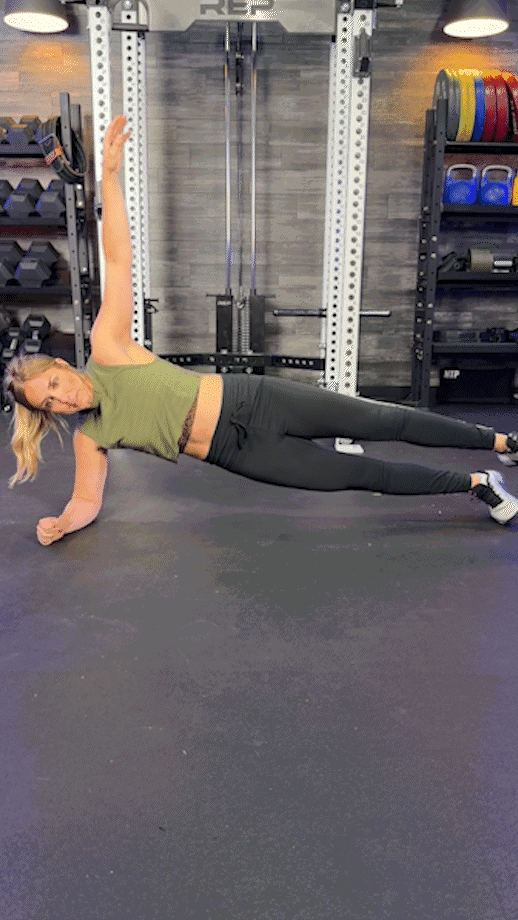
30-Day Ab Challenge Calendar
Here’s the 30-day ab challenge in a calendar format along with a format refresher:
- Days 1-7: 30 seconds per exercise with 30 seconds rest between exercises
- Days 8-14: 40 seconds per exercise with 20 seconds rest between exercises
- Days 15-21: 50 seconds per exercise with 10 seconds rest between exercises
- Days 22-30: 60 seconds per exercise with no rest between exercises
Print off the calendar and stick it to your wall so you know what to do every day.
| Day 1 30 sec / 30 sec rest Dead bugs Toe touches Russian twists Mountain climbers Plank | Day 2 Repeat Day 1 | Day 3 Repeat Day 1 | Day 4 Repeat Day 1 | Day 5 Repeat Day 1 | Day 6 Repeat Day 1 | Day 7 Repeat Day 1 |
| Day 8 40 sec / 20 sec rest Sit-ups Lying leg raises Plank Shoulder taps Cross-body mountain climbers Hollow hold & rocks | Day 9 Repeat Day 8 | Day 10 Repeat Day 8 | Day 11 Repeat Day 8 | Day 12 Repeat Day 8 | Day 13 Repeat Day 8 | Day 14 Repeat Day 8 |
| Day 15 50 sec / 10 sec rest Weighted crunches Hanging knee raises Weighted Russian twists V-up Side plank | Day 16 Repeat Day 15 | Day 17 Repeat Day 15 | Day 18 Repeat Day 15 | Day 19 Repeat Day 15 | Day 20 Repeat Day 15 | Day 21 Repeat Day 15 |
| Day 22 60 sec / No rest Ab rollouts L-sits Landmine rotations Hanging leg raises Side star plank | Day 23 Repeat Day 22 | Day 24 Repeat Day 22 | Day 25 Repeat Day 22 | Day 26 Repeat Day 22 | Day 27 Repeat Day 22 | Day 28 Repeat Day 22 |
| Day 29 Repeat Day 22 | Day 30 Repeat Day 22 |
30-Day Ab Challenge: Final Thoughts
Building strength in the core goes beyond aesthetics and chiseled midsections. Following this 30-day ab challenge will give you a range of core exercises to add to your repository, and may improve your posture, better your athletic performance, and reduce lower back pain.
Because you’ll be hitting your abs every day for 30 days, I wouldn’t recommend doing additional core exercises. You can either do them as a standalone workout at the start or end of your day or include this workout challenge after your regular workout. The choice is yours.
All that’s left to say is good luck!
30-Day Ab Challenge: FAQs
What is the best 30-day ab challenge?
The best 30-day ab challenge is the one you can stick to for 30 days. As a certified personal trainer, I’ve seen hundreds of challenges over the past decade and have even designed a 30-day ab challenge myself. Look through what each one requires, whether you think you’ll be able to adhere to it, and give it a go. You’ll never know until you try!
Can you really get abs in 30 days?
This is a great question! Several factors determine whether you can get abs in 30 days, including, but not limited to, your starting position, your nutrition, how often you exercise, and more. Someone with a relatively low body fat percentage and who changes their diet and exercises can see abs in 30 days. For others, it may take longer.
Will 100 crunches do anything?
A hundred crunches will burn more calories than doing zero crunches, that’s for sure. You may also improve your posture and athletic performance if you don’t regularly do core exercises. However, if your fitness goal is to see abs, there’s more to it than doing crunches. Above everything, proper nutrition and being in a calorie deficit is key.
What exercise burns the most belly fat?
If weight loss is your goal, there are certain exercises you can do that burn more calories than other exercises. Compound exercises such as back squats and deadlifts are great examples because they work multiple muscle groups, and therefore, expend more calories. To burn belly fat, having the correct nutrition is the most important factor. As they say, you can’t out train a bad diet.
References
- Chang WD, Lin HY, Lai PT. Core strength training for patients with chronic low back pain. J Phys Ther Sci. 2015 Mar;27(3):619-22. doi: 10.1589/jpts.27.619. Epub 2015 Mar 31. PMID: 25931693; PMCID: PMC4395677.
- Pereira ILR, Queiroz B, Loss J, Amorim C, Sacco ICN. Trunk Muscle EMG During Intermediate Pilates Mat Exercises in Beginner Healthy and Chronic Low Back Pain Individuals. J Manipulative Physiol Ther. 2017 Jun;40(5):350-357. doi: 10.1016/j.jmpt.2017.02.010. Epub 2017 Apr 13. PMID: 28413116.
- Park S, Choi BH, Jee YS. Effects of plank exercise on respiratory capacity, physical fitness, and immunocytes in older adults. J Exerc Rehabil. 2023 Dec 26;19(6):332-338. doi: 10.12965/jer.2346536.268. PMID: 38188128; PMCID: PMC10766451.
- Moraes AC, Pinto RS, Valamatos MJ, Valamatos MJ, Pezarat-Correia PL, Okano AH, Santos PM, Cabri JM. EMG activation of abdominal muscles in the crunch exercise performed with different external loads. Phys Ther Sport. 2009 May;10(2):57-62. doi: 10.1016/j.ptsp.2009.01.001. Epub 2009 Mar 10. PMID: 19376473.
Further reading

Chest day is the best day! Celebrate by working some of the best chest exercises into your next upper-body routine! Let’s get to it! Read more

Follow our seven tips for children-treadmill safety. Read more

Explore our Ritual pregnancy protein powder review, offering insights on taste, solubility, and formulation to help you make an informed decision on your unique pregnancy journey. Read more

In this Transparent Labs LEAN review, we tested out and rated our experience using this pre-workout that also doubles as a fat burner. Read more

